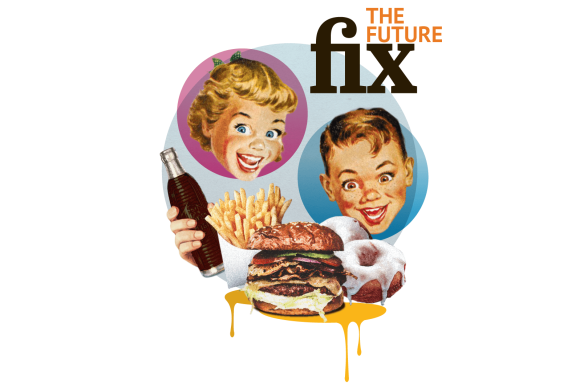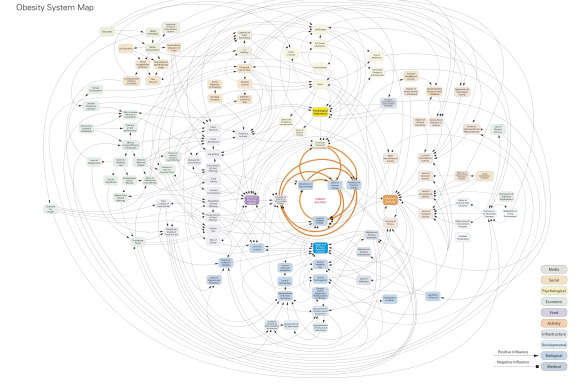Explainer
- Explainer
- The future fix
While politicians refuse to act, Australians become more overweight
In the final instalment of The Future Fix, Dana McCauley examines Australia’s snowballing obesity crisis. Despite health experts offering solutions, politicians have failed to act, leaving us in the grip of a silent epidemic.
By Dana McCauley

Credit: Matthew Absalom-Wong
After thousands of pages of submissions and four days of public hearings, health advocates thought they had a solution to Australia's obesity crisis.
Australia's top public health experts – who for more than a decade have been campaigning for reforms to address a snowballing yet preventable health crisis – had made their case over dozens of hours, putting reams of statistical evidence on the public record.
Australia is ranked fifth for obesity in the OECD, with more than two-thirds of adults above a healthy weight and almost a third obese. A quarter of the nation's children – more than 1.2 million – are overweight or obese.
It wasn't our fault that we were fat, the experts said, and a few simple policy changes could help turn the ship around.
But their hoped-for outcome was about to be thwarted by political reality.
Typing up his report as chair of the Senate committee inquiry into the obesity epidemic, Greens senator Richard Di Natale – a former GP – inserted two recommendations widely considered essential to addressing the crisis: restrict junk food advertising and tax sugary drinks.
But one of two Labor senators on the committee, who had indicated support for these measures, did an about-turn.
That meant that two Liberals, two Labor members and a One Nation senator opposed the solutions while just two supported the measures: Di Natale and independent senator Tim Storer.
The result was a report that, bizarrely, contained recommendations supported by only two of the seven committee members. (Usually these reports, written by the chair, represent a majority view, with dissenters listing their reasons at the end.)
It is understood that senator Lisa Singh, the committee's deputy chair, had reversed her position after a fiery debate with fellow Labor senator Kimberley Kitching.
Kitching, who had missed a number of committee meetings, had been quick to pull Singh into line with the party's official policy when she learnt her colleague had gone off script.
Opposition health spokeswoman Catherine King – listed as a key lobbying target by the Australian Beverage Council in its annual report – had said earlier this year that Labor did not support a sugar tax.
But after Opposition Leader Bill Shorten said last year he was concerned about the impact of junk food marketing on kids, some health advocates had been hopeful of Labor support for restrictions on advertising before 9pm, when many children watch television with their families.
In their dissenting comments on the committee report, released in early December, Labor senators would support only a review of junk food advertising, leaving health advocates frustrated.
Singh has declined to comment.
A Labor source said the party regarded the proposed sugar levy as “a regressive tax” and accused the Greens of “virtue signalling”.
The conflicting report illustrates the fraught political atmosphere surrounding a health crisis that is engulfing a growing number of Australians, and shows why persistent calls for a united national approach have failed to produce results.
A decade ago, then prime minister Kevin Rudd set out to tackle the obesity crisis by setting up a preventive health taskforce, only to have one of its members – respected diabetes expert Professor Paul Zimmet – excoriate the government for failing to implement key recommendations.
Meanwhile, Australians have kept getting fatter – and it's not just vulnerable or disadvantaged groups who are at risk.
In Australia, 67 per cent of adults are overweight or obese and 31 per cent have tipped the scales to become medically obese, according to the latest Australian Bureau of Statistics data for 2017-18.
More than 35 per cent of energy intake in adults and more than 39 per cent in children is from “discretionary food and drinks” – those with little or no nutritional value and laden with kilojoule-rich sugar and fat, says the Public Health Association of Australia.
They push back very hard because these kind of policies are effective.
Obesity Policy Coalition executive manager Jane Martin, a veteran public health campaigner who fought for plain packaging and higher taxes on tobacco products, said a major reason there had been “very little action” on obesity was the influence wielded by the junk food industry.
“There's a lot of push back. That makes politicians concerned and scared,” Martin said.
“And they push back very hard because these kind of policies are effective. That's pricing policies, controlling promotion and controlling the availability [of junk food and sugary drinks].”
The “push back” comes from groups such as the Australian Food and Grocery Council, the peak body for the packaged food industry; the Australian Beverages Council, representing soft-drink producers; Coca-Cola Amatil, which makes a range of soft drinks (as well as bottled water and, more recently, the fermented drink kombucha); and KFC (Kentucky Fried Chicken) – all of whom made submissions to the obesity inquiry.
Australia's packaged food and beverage industries have resisted any rules forcing them to change the composition of their products to reduce the fat and sugar used to make them taste better, but some producers have begun “reformulating” products themselves to get ahead of a potential sugar tax.
The industries turn over more than $127 billion a year in Australia.
Martin said there were parallels between the actions taken by the tobacco industry and the sweetened beverages industry, which was using “self-regulation” to stave off a sugar tax.
Coca-Cola announced earlier this year that it would cut the amount of sugar added to its beverages by 20 per cent by 2025.
The Australian Beverages Council, which has a strong lobbying presence in Canberra, in a submission to the inquiry dismissed the sugar tax as “a simplistic measure”.
“The facts supporting it being a cost-effective, viable intervention with limited consequences are non-existent,” the council said.
It also pointed to ABS data showing that the single largest contributor to empty kilojoules (and not just sugar intake) in Australian diets was alcohol, followed by cakes, lollies and chocolate.
In a similar vein, Coca-Cola said that “while there is no doubt too much sugar is not good for anyone, the evidence for a beverage-based sugar tax is far from conclusive when it comes to reducing obesity rates”.
Coca-Cola Amatil is already battling a flat market for sugary drinks, with its Australian beverages division having marked a challenging 2017 with underlying earnings before interest and tax down 6.4 per cent to $412.6 million.

Sugar cane (burned as part of the harvest process). Politicians fear that a sugar tax would see their goodwill with cane farmers go up in smoke. Credit: Robert Trough
Also at play are the so-called sugar seats in Queensland and northern NSW, where Australia's sugar cane industry is centred and MPs in marginal electorates are loathe to take any action that could be perceived as detrimental to farmers.
Grattan Institute health economist Stephen Duckett said the amount of sugar cane that would be diverted if Australia implemented a sugary drinks tax was “trivially small”. (More than 80 per cent is exported, according to the Australian Sugar Industry Alliance.)
People are fearful, especially in Queensland where Pauline Hanson is able to say that the interests of sugar-cane growers are being sacrificed to support change on behalf of people in Melbourne and Sydney.
“But it's easy to manipulate the sugar-cane growers who might think, oh, it's my particular sugar cane which is not going to be sold in Australia,” he said.
“So people are fearful, especially in Queensland where Pauline Hanson is able to say that the interests of sugar-cane growers are being sacrificed to support change on behalf of people in Melbourne and Sydney.”
Di Natale warned that Australians would be “the first generation to hand over a lower life expectancy to our kids than the one we enjoyed” if politicians did not follow expert advice.
The Greens leader called for new laws banning politicians from receiving donations from companies that sell junk food or sugary drinks.
The word obesity is so loaded that the Senate report devoted a whole section to stigma, suggesting that alternative turns of phrase, such as healthy weight, be used in prevention programs.
Its causes are so complex that the Senate report includes a mind map from the UK government showing how more than 100 interrelated factors can interact to make a person overweight. The map is described in the report as “largely impenetrable”.
The World Health Organisation defines overweight as a body-mass index (BMI) greater than or equal to 25. Obesity is defined as a BMI greater than or equal to 30. A person's BMI is calculated by dividing their weight in kilograms by the square of their height in metres. (You can calculate yours here.)
There will be 50 per cent more obese people by 2025, and the cumulative marginal economic costs to Australia will reach $87.7 billion.
Whichever way you spin it, Australians being overweight or obese contributed 7 per cent of the total health burden in 2011 and cost the economy $8.6 billion, according to the Australian Institute of Health and Welfare.
PricewaterhouseCoopers concluded that, without increased investment in well-designed obesity interventions, there will be 50 per cent more obese people by 2025, and the cumulative marginal economic costs to Australia will reach $87.7 billion.
Being overweight or obese increases risk for at least 13 types of cancer, including breast and colon cancer, and heightens the risk of developing chronic diseases, including cardiovascular disease and type-2 diabetes.

A "map" showing the inter-related causes of obesity, from the UK government.
Alongside the rise of obesity, there has been an explosion in the rates of type-2 diabetes, with which at least 1.2 million Australians aged 18 or older have now been diagnosed – that's 6 per cent of adults.
Diabetes Australia chief executive Professor Greg Johnson said Australia seemed to be “going backwards in terms of the level of political or government interest” in trying to address both conditions.
“The problem here is that we're talking about a silent epidemic as opposed to what are obvious epidemics,” Johnson said, pointing to interventions to address the smallpox and influenza outbreaks of the 20th century.
“When things happen that are acute and short term, we often see governments take action very quickly, because they have no alternative but to act.
“The morbidity and mortality in the 21st century of chronic conditions is on a bigger scale than, in fact, the infectious disease epidemics,” Johnson said. “However it's slow, it's less visible, it's less obvious – and so we don't get anxious.”
It's not that people just became irresponsible – the environment around them has changed.
Part of the solution, he said, was to shift thinking to make the consequences of unhealthy lifestyles “much more tangible”.
“These chronic conditions are going to have an impact on the national productivity,” he said.
Di Natale said overweight Australians should not be blamed for their condition.
“Something has shifted over the last 30 to 40 years,” he said. “It's not that people just became irresponsible - the environment around them has changed.”
The Grattan Institute's Duckett agreed, saying it was “all very well to say people need to take personal responsibility but we've got to make healthy choices easy choices".
“It's not necessarily easy when there are a whole lot of social pressures and advertising pressures and so on, which encourage us to increase our calorie intake beyond our activity output,” he said.
The Australian Medical Association said in its submission that combating obesity “demands a whole of society approach” and that prevention efforts should be targeted at children – starting at preconception and pregnancy.
Childhood obesity has increased significantly and children as young as eight are being diagnosed with type-2 diabetes.
Children face short-term health impacts such as breathing difficulties, fractures, hypertension, insulin resistance and early markers of cardiovascular disease. Long term, they face the risk of cardiovascular disease, diabetes, musculoskeletal disorders and cancers.
Submissions to the Senate inquiry highlighted the fact that GPs often shied away from alerting parents that their child had reached an unhealthy weight.
How can a parent make a choice when something is presented to them as 99 per cent fruit and veg but it's actually 60 per cent sugar?
Some doctors did not themselves recognise the warning signs, due to overweight having become normalised.
And parents had to grapple with confusing and often “misleading” food labelling.
“How can a parent make a choice when something is being presented to them as 99 per cent fruit and veg but it's actually 60 per cent sugar?" Johnson said, referring to Heinz's Little Kids Shredz. The processed food manufacturer was ordered to pay a $10 million fine for “deliberately misleading” consumers by describing the range, marketed for toddlers, as healthy.
One recommendation in the Senate report that won majority support - although it was opposed by Liberal and One Nation senators - was that the Health Star Rating system be fixed to ensure that foods high in sugar, sodium and saturated fat were appropriately labelled.
It called for the system to be made mandatory by 2020, and for industry representatives to be removed from the decision-making body that gives packaged food its rating out of five stars.
Another was the recommendation to create a national obesity strategy taskforce to sit inside the Health Department.
Liberal and One Nation senators opposed this recommendation, too.

There are calls for tighter restrictions on junk food advertising.Credit: Andrew Quilty
As obesity rates continued to rise and children developed chronic diseases at increasingly younger ages, the Obesity Policy Coalition's Martin said governments would be forced to act.
As well as advocating for a tax on sugary drinks, she said there was inadequate oversight of junk food marketing to children on television and other platforms, including social media.
“The most popular programs with children have a lot of junk food sponsorship through them,” she said, citing prime-time family shows such as MasterChef, The Block and Ninja Warrior.
In England, major supermarket chains changed the formulation of home brand products to reduce sugar, in advance of the [sugar] tax.
She said a national strategy must encompass education, healthcare, urban planning and public transport. “All these things impact on what we eat and how much activity that we do,” she said.
Other measures included changing what is sold in school canteens and making it easier for people to ride bicycles.
Duckett called on retailers to step up their efforts at corporate responsibility.
“What's been dramatic in England is, when they brought in a sugar tax, major supermarket chains changed the formulation of home brand products to reduce sugar, in advance of the tax coming in.”
The Butterfly Foundation, which supports people with eating disorders, used its submission to the Senate inquiry to highlight that one in five obese Australians are estimated to have an eating disorder.
“Obesity and eating disorders both revolve around unhealthy beliefs and behaviours around weight and eating,” the foundation said, calling for greater dialogue between the two treatment sectors.
But while the complexity of obesity is recognised by the experts, they say policy levers can have an impact.
“We've got to make it easier for people to moderate their calorie intake and we've got to actually send some signals,” Professor Duckett said.
The sugar tax was not just about decreasing consumption through a price increase, he said.
“It's also labelling saying 'this drink has a tax' - so people are confronted much more directly with the information.”
But would an extra 20 cents on a can of soft drink really make a difference?
“It does. Every bit helps,” he said.
“It doesn't fix the problem, but every bit changes behaviour.”
Let us explain
If you'd like some expert background on an issue or a news event, drop us a line at explainers@smh.com.au or explainers@theage.com.au. Read more explainers here.